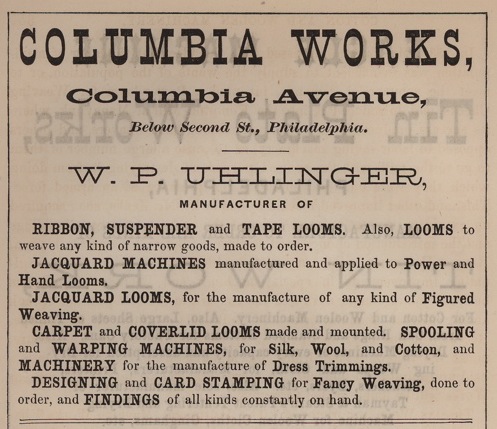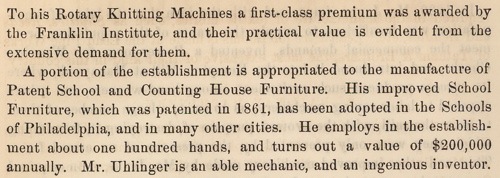
Southern facade along Columbia / C.B. Moore Avenue, between Mascher Street (at right) and Hancock Street. Embedded in the brick above the cars is a cast iron sign stating "W.P. Uhlinger."
Columbia Works, 1867-
Eagle Bolt Works, 1875-
155 Cecil B. Moore Avenue, Philadelphia PA 19122
(north side of formerly Columbia Avenue between Hancock Street and Mascher Street)
© Carmen A. Weber, Irving Kosmin, and
Muriel Kirkpatrick, Workshop of the World (Oliver Evans
Press, 1990).
The first building on this irregular
corner where Columbia Avenue angles across Mascher Street
was a three story brick building erected in 1867.
1
It housed the Columbia
Works of W.P. Uhlinger, which manufactured school desks
and power looms. The main building served as a machine
shop with wood sawing, planing, and varnishing rooms.
Behind the building was the engine room, blacksmith shop,
and sheds for storing wood and iron stock. As Uhlinger
manufactured power looms it is probable he was related to
the Uhlinger who later established a large textile
machine works on Glenwood Avenue at 2nd Street, where the
name still appears painted above the first story. In 1883
Uhlinger was located further south on Canal Street where
he was "especially occupied with improved looms and other
textile machinery." 2



images © Freedley,
Philadelphia and its
Manufactures (1867), p. 356-358.
A survey of 1875 3
indicated the change of
ownership and the addition of several more substantial
brick buildings to the main factory on the corner. Called
Eagle Bolt Works, the owners, Keim and Welsh,
manufactured bolts and nuts in a one story machine and
hammer shop, with clearstory, extending 175 feet along
Hancock Street. This building had an ell, also with
clearstory, housing the "Oliver" shop. The oliver was an
old type of smith's hammer, operated by a treadle, with
the hammer held off the work by a spring pole. As with
the previous operation here, there was a blacksmith shop,
an engine room, and various storage sheds, and the
triangular plot of ground formed by the angle of Columbia
Avenue is still a garden. At this date the second and
third floors of the main building are leased to John
Scanlin and Son who employ 50 hands on 60 power looms to
weave cotton and woolen goods.
In 1888 Eagle Bolt Works still occupied the whole
property, but an 1887 atlas indicated Thomas Van Antwerp
was then the owner, neither atlas noted the industrial
activity in the buildings. 4
The 1891 Hexamer insurance
map clearly showed the bolt works smithing operations but
the owners were now Welsh and Lea, and the Vaughn and
Bower hosiery mill replaced the Scanlin weaving
firm. 5
Some time after this a triangular-shaped extension was
added to the building on the odd corner. This two story
building had a corbelled brick cornice with a
crossed-brick design that linked it to Dolan's and the
Scotch Snuff Mill on the block to the south.
In 1895 an atlas showed that the property on the south
end of the block switched to the profitable
leather-working industry, a later atlas associated the
name of Margaret I. Illingworth with the "Calf-Kid
Works." 6
In 1922 the industrial process changed again and the
buildings became a paper box factory, owned by Donaldson
et al. 7
In 1945 paper boxes
continued to be made by the John C(r)ompton-Adelphia
Corporation, a joining of two companies who earlier were
listed at other addresses in the west Kensington
area. 8
Today a sign along Mascher
Street identifies a part of the building as the
Philadelphia Carpenter Machinery Co., a return to an
aspect of its initial use.
1 "Columbia Works, W.P. Uhlinger" - Hexamer
#304.
2
Blodget, Census of
Manufactures, p. 69.
3
"Eagle Bolt Works, Keim & Welsh" (1875)
- Hexamer #891.
4 George W. Baist, Baist's
Atlas of the City of Philadelphia, Pennsylvania,
complete in one volume, (Philadelphia, 1888); and
Bromley, 1887.
5
Hexamer and Son,
1891.
6
George W. Bromley,
Atlas of the City of Philadelphia, complete in one
volume, (Philadelphia, 1895); and Bromley, 1910.
7
Bromley, 1922.
8
Sanborn Map Company,
1945.

Update
May 2007 (by Torben
Jenk):
The triangular
section at the southwest, which followed the bend in
Columbia Avenue, was removed within the last decade and a
cast iron plaque was revealed stating "W.P. UHLINGER."
The one-story section along Hancock Street suffered
bulging walls and the roof was removed within the last
decade; the stuccoed walls remain. Now used by a
cabinetmaker and for various studio
spaces.